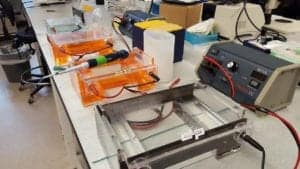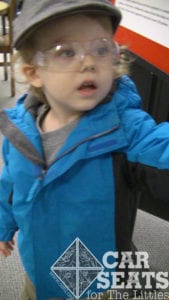Sucrose, glutamic acid, isoleucine, arginine, oleic acid, palmitic acid, stearic acid, phytosterols, ethyl ethanoate, 3-methylbutyraldehyde, pentanal, methyl butyrate, octene, hexanal, styrene, nonane, non-1-ene, benzaldehyde, butylated hydroxytoluene, and methyl paraben. Would you give a product containing these ingredients to your child? Barring an allergy… you probably would. Because that’s a partial ingredients list for an all-natural blueberry.
About Chemical Names

Image courtesy of CSFTL friend Jena “Cheddah” Yamada
Chemical names can sound scary. But the truth is, many of them are naturally occurring in items we eat, touch, or use every day. Just because it has a name like ‘arginine’ (a very necessary amino acid, for the record), does not make it inherently dangerous. The toxicity of anything, including water and oxygen, is all in the dose – an oxygen level below about 14% will kill you. But so will an oxygen level that’s too high.
Chemicals! In my Child’s Car Seat!

Image courtesy of CSFTL friend Jena “Cheddah” Yamada
Many parents express concern over the chemical flame retardants used on their children’s car seats. How dangerous are these chemicals? Well, you shouldn’t drink them. I don’t recommend swimming in them, either. But the amount applied to a car seat simply does not carry the hazard that a vat of the stuff would – as we say in the lab, the solution to pollution is dilution. But why do car seat manufacturers use these compounds in the first place?
Well, for a start, they’re federally mandated – all car seats sold in the US and Canada are required to meet fire retardancy standards. And this is a good thing. The flame retardants mean that the car seat’s cover will smolder instead of erupting into flame. In the event that you were ever to be caught in a vehicle fire, that buys you precious extra seconds to get your child safely out of the car seat.
Don’t Panic!

Image courtesy of CSFTL friend Jena “Cheddah” Yamada
There are a few studies that claim that some car seats have more chemical retardants on them than others, but these studies don’t really tell us much of anything about potential transfer of chemical from the car seat to the child. They use gas chromatography-mass spectroscopy, which is a logical technique for seeing what’s present in a substance.
The trouble is that the word ‘gas’ here is important – you can’t shoot a solid car seat cover on the instrument. The logical course of action would be to use a wipe test, wherein the cover is wiped down, and the wipe is rinsed with a solvent. The solvent is injected onto the instrument, and heated until it becomes a gas – this would tell us how readily the chemicals which are on the car seat come off of the car seat with normal contact. The studies run, however, have not been wipe test studies. They’ve mostly used acid digestion. This means that the cover has been dissolved in a strong mineral acid, and the acid has then been analyzed on the instrument. This really doesn’t tell us anything helpful – it tells us that flame retardants are present (we already knew that), but it doesn’t tell us how readily they transfer from the car seat to the child, or if they can even do so at all.

Budding Chemist!
Since kids are not playing with strong acid in the car on the way to day care (not even this little guy!), that doesn’t give us any kind of meaningful picture of transfer risk. Some studies have also used organic extraction, where the cover is soaked in organic solvent to see what comes out of it – this poses the same problem, in that it doesn’t tell us anything about what kind of transfer we’d see under normal use.
These methodologies also don’t tell us anything about the possibility of flame retardants to ‘off-gas’, and yet that term gets thrown around these reports like a baseball. In the absence of any kind of evidence of significant transfer from the car seat to the child, these reports are nothing more than fearmongering.
Chemicals are Everywhere
The fact is, we get a lot more exposure to chemicals, including flame retardants, from other sources. Even for families who travel a lot, exposure to a flame retardant mattress is going to be far greater than exposure to a car seat. If you’re concerned, washing the car seat’s cover according to the manufacturer’s instructions and wiping down the harness with a damp cloth or baby wipe before using it for the first time to remove any unbonded material certainly won’t hurt anything and may give you some peace of mind. And then… buckle up, and safe travels!
About the Author
CSFTL Admin Allison is a chemist by day. She’s combined her two worlds to write this article for us!

Guest Author Allison
